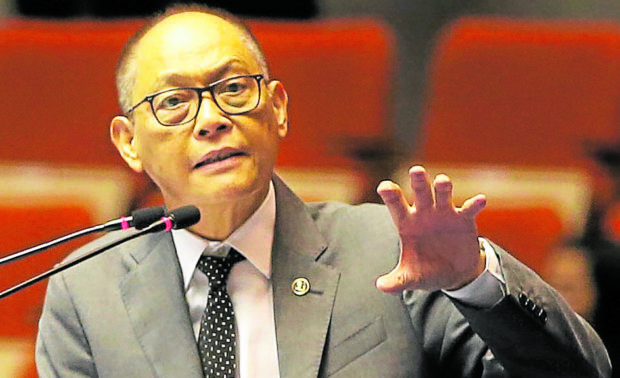
Benjamin Diokno. INQUIRER FILES
The Marcos administration is sticking to its growth target for the domestic economy of 6 percent to 7 percent in 2023 despite private institutions and experts as well as the government’s own think tank downgrading their forecast to less than 6 percent, according to Finance Secretary Benjamin Diokno.
“For the Philippines, the worst is over and the best is yet to come,” Diokno said in a statement, adding that there were many factors that would enable an outcome that would be better than the various forecasts.
The finance chief paints this picture against the background of a widely expected mild global recession in 2023 amid the lingering effects of the pandemic, exacerbated by the continuing Russian invasion of Ukraine as well as the weakening of growth in China, which is suffering from yet another wave of COVID-19.
Earlier this month, the World Bank lowered its forecast on the growth of the Philippine gross domestic product (GDP) to 5.7 percent from the 5.8 percent forecast three months earlier.
The Asian Development Bank is more optimistic with a projection of 6 percent, albeit still below the government’s goal.
Consumer spending
ING Bank is more conservative with a forecast of “roughly 5 percent,” taking into account their expectation that consumer spending will lose steam next year.
“The Development Budget Coordination Committee predicts that the Philippine economy will grow by 6 percent to 7 percent in 2023 in the face of external headwinds,” Diokno said.
“But an average GDP growth of 6.5 percent is nothing to be sneezed at—it is still one of the highest, if not the highest, growth rates among Asean+6 economies,” he added. He was referring to the Association of Southeast Asian Nations—the Philippines, Indonesia, Thailand, Malaysia, Singapore, Brunei, Cambodia, Laos, Myanmar and Vietnam—and its dialogue partners, China, Japan, South Korea, India, Australia and New Zealand.
As basis for optimism, Diokno mentioned the early approval of the 2023 national budget; the early adoption of the “first-ever Medium-Term Fiscal Framework” that emphasizes fiscal consolidation; the swift approval of the Philippine Development Plan 2023-2028; the country’s international credit profile remaining strong at investment grade, and the stable and resilient banking system.
Diokno also cited adequate buffers against external headwinds such as a hefty stock of international reserves; a more favorable economic environment that removes barriers to foreign investments and further opens economic sectors to foreign equity; the country’s young labor force; and the government’s commitment to continue and further expand the “Build, Build, Build” program.
Unity
“As long as the country stays united and its political leaders and policy makers remain focused on economic growth, the Philippines’ future remains bright,” he said. “The trajectory of its growth will make the country one of the leading economies in the Asia-Pacific region.”
Meanwhile, researchers at the state-run Philippine Institute for Development Studies (PIDS) expect GDP growth to weaken in 2023 at 4.5 percent to 5.5 percent.
Findings of a study conducted by PIDS senior research fellow Margarita Debuque-Gonzales, supervising research specialist John Paul Corpus, and research analyst Ramona Maria Miral anticipate further rough sailing in 2022 and 2023, as the country faces a new set of headwinds amid high inflation and widespread monetary tightening—a recipe for a broad, global slowdown.
“Financial volatility in advanced countries has been spilling over to emerging market economies, increasing the complexity of issues and challenges faced by local policymakers in these places,” they said.
The researchers see GDP growing within target at about 7.1 percent in 2022, but below target in 2023 due to the “gloomy and uncertain” outlook for the world economy. INQ